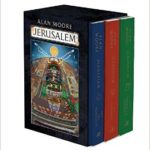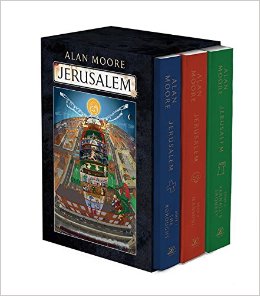BOOK REVIEW: JERUSALEM by Alan Moore

In mid-2016, noted graphic novelist and self-professed warlock Alan Moore released his second literary novel, Jerusalem, and it’s a doozy. A 600,000 word Joycean meditation on the lifeblood and history of a single neighborhood in Northampton, UK, the author’s hometown and lifelong residence, this book is an epic journey that seems to go everywhere and yet nowhere.
From Moore’s own blurb: In the half a square mile of decay and demolition that was England’s Saxon capital, eternity is loitering between the firetrap tower blocks. Embedded in the grubby amber of the district’s narrative among its saints, kings, prostitutes and derelicts a different kind of human time is happening, a soiled simultaneity that does not differentiate between the petrol-coloured puddles and the fractured dreams of those who navigate them…
Written in a wide variety of voices, viewpoints, and styles—one long chapter appears in the form of a Samuel Becket-like play—the novel, divided into three sub-books, is centered around a particular bloodline in the form of a modern brother and sister, Mick and Alma Warren. He’s an ordinary laborer while she is a semi-famous artist who cut her teeth doing comic and science fiction book covers, and whose upcoming art show represents a nexus of history of the neighborhood in much the same way that I suspect Moore views his novel.

Portrait of the artist by Mitch Jenkins.
Mick’s role in the story most prominently involves a childhood incident in which he nearly chokes to death on a throat lozenge, an experience that takes us into a rip-snorting adventure through the afterlife, the inter-dimensional and heavenly planes coexisting alongside the raw, decaying, “trans-temporal chess game” that makes up the material reality of “the Buroughs.” As angels and demons do battle over the disposition not of Mick’s soul but of his earthly activities, the cough-drop sequence, representing both the physical and spiritual center of the novel and which comprises the whole of book two, makes for one hell of a psychedelic literary trip.
As for the rest of Jerusalem, many may find themselves struggling in vain to find a typical plot-thread on which to hang their reader’s hat, and on that level the novel fails to engage. Innumerable pages go by as characters literally walk alone and observe the neighborhood, all described in great and voluminous gales of elegant, eloquent language that in the end feels like it’s coming from one fount rather than the various points of view of the individual characters.
While the language alone provided enough grist for this lover of the written word to keep plowing on through to the end, one wonders about the resilience and tenacity of the average reader who might decide to take the plunge into what for most will be a months-long journey that at times sorely lacks the kind of interpersonal conflict that keeps people flipping pages.
For me the time spent was worth it; at quite a few of the novel’s best written passages, I experienced what can only be called soul-uplift. At other times, however, I felt frustration, and considered giving it up; the outright Joyce tribute (or satire) in book three provoked the urge to skip many pages. But still I kept on, and by the end felt enormously rewarded for having expended the effort.
But let’s face it, books like Jerusalem aren’t intended for “average” readers—a novel like this represents a singular artistic statement, perhaps an ultimate one, for Alan Moore. More power to him not only for getting this manuscript written, but for seeing it through to publication. Is it an artistic success, in the traditional sense? Perhaps not, but it exists, and has quite a bit to say about life, in particular the journey of the artist. Recommended, but with the caveat that it’s far from a light read.
About dmac
James D. McCallister is a South Carolina author of novels, short stories, journalism, creative nonfiction and poetry. His neo-Southern Gothic novel series DIXIANA was released in 2019.
